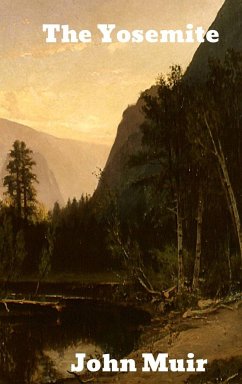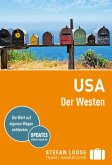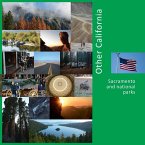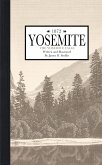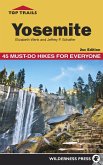In the classic nature work, The Yosemite, the great American naturalist, John Muir, describes the Yosemite valley's geography and the myriad types of trees, flowers, birds, and other animals that can be found there.The Yosemite is among the finest examples of John Muir nature writings.The Yosemite is a classic nature/outdoor adventure text and a fine example of John Muir nature writings. In this volume, Muir describes the Yosemite valley's geography and the various types of trees, flowers and animals that can be found there.John Muir (April 21, 1838 - December 24, 1914) also known as "John of the Mountains" and "Father of the National Parks",was an influential Scottish-American naturalist, author, environmental philosopher, glaciologist and early advocate for the preservation of wilderness in the United States. His letters, essays, and books describing his adventures in nature, especially in the Sierra Nevada, have been read by millions. His activism has helped to preserve the Yosemite Valley, Sequoia National Park and many other wilderness areas. The Sierra Club, which he co-founded, is a prominent American conservation organization. The 211-mile (340 km) John Muir Trail, a hiking trail in the Sierra Nevada, was named in his honor.[6] Other such places include Muir Woods National Monument, Muir Beach, John Muir College, Mount Muir, Camp Muir, Muir Grove, and Muir Glacier. In Scotland, the John Muir Way, a 130-mile-long route, was named in honor of him.In his later life, John Muir devoted most of his time to the preservation of the Western forests. As part of the campaign to make Yosemite a national park, Muir published two landmark articles on wilderness preservation in The Century Magazine, "The Treasures of the Yosemite" and "Features of the Proposed Yosemite National Park"; this helped support the push for U.S. Congress to pass a bill in 1890 establishing Yosemite National Park. The spiritual quality and enthusiasm toward nature expressed in his writings has inspired readers, including presidents and congressmen, to take action to help preserve large nature areas.[8]John Muir has been considered "an inspiration to both Scots and Americans". Muir's biographer, Steven J. Holmes, believes that Muir has become "one of the patron saints of twentieth-century American environmental activity," both political and recreational. As a result, his writings are commonly discussed in books and journals, and he is often quoted by nature photographers such as Ansel Adams. "Muir has profoundly shaped the very categories through which Americans understand and envision their relationships with the natural world," writes Holmes. John Muir was noted for being an ecological thinker, political spokesman, and religious prophet, whose writings became a personal guide into nature for countless individuals, making his name "almost ubiquitous" in the modern environmental consciousness. According to author William Anderson, Muir exemplified "the archetype of our oneness with the earth", while biographer Donald Worster says he believed his mission was "...saving the American soul from total surrender to materialism.":403 On April 21, 2013, the first ever John Muir Day was celebrated in Scotland, which marked the 175th anniversary of his birth, paying homage to the conservationist.

Für die Tasche Wie der Yellowstone-Nationalpark zählt auch das Yosemite Valley in Kalifornien zu den mystisch verehrten Landschaften der USA. Dazu haben viele Menschen beigetragen, auch der Fotograf Ansel Adams, der diese Schönheit der Welt zeigte. Jene Schönheit, die der Umweltaktivist John Muir so beschrieb: Im Merced River "spiegeln sich Maiglöckchen und Bäume und die alles überschauenden Felsen. Zarte und flüchtige Dinge treffen hier auf die Ewigkeit und vermischen sich in unzähligen Formen, und es hat den Eindruck, als hätte Mutter Natur in diesem Bergpalast ihre ausgesuchtesten Schätze versammelt, um ihre Liebhaber zu beeindrucken und in ihren Bann zu ziehen." Yosemite war 1864 eines der ersten Schutzgebiete, noch vor der Gründung des Yellowstone-Nationalparks. Geschützt werden sollte die landschaftliche Schönheit und der touristische Wert. 1903 besuchte Präsident Roosevelt gemeinsam mit John das Gebiet.
1912 schrieb John Muir sein Buch "Yosemite", das nun bei Matthes & Seitz auf Deutsch neu erschienen ist. Es ist eine Lobpreisung des Naturparadieses und eine akkurate Beschreibung der Pflanzen- und Tierarten, der gigantischen Felsen und der Riesenmammutbäume. Es erscheint in der Reihe "Naturkunden" und ist wunderschön aufgemacht. Feines Papier, schöner Druck, ansprechendes Cover. Aber damit wollte man es wohl nicht bewenden lassen und hat einen Coup gelandet: Das Vorwort stammt von Mordecai Ogada. Und das ist ein Problem. Der kenianische Ökologe und Essayist schreibt seit Jahren furios und unversöhnlich gegen den Naturschutzgedanken an. Er sieht darin eine Fortsetzung des Kolonialismus mit anderen Mitteln. Natürlich hat Ogada oft recht. Etwa wenn er schreibt, die Sichtweise europäischer Kolonisten in aller Welt bestimmte, "welcher Teil der Biodiversität getötet und welcher gerettet werden sollte". Die Wünsche der Weißen beeinflussten, "was in der Natur als zu eliminierendes Ungeziefer gilt, was aus Prestigegründen als Trophäe gejagt werden soll und was wertvoll genug ist, um durch den Einsatz von Gewalt geschützt zu werden". All das gilt vor allem für den afrikanischen Kontinent. Dort - aber auch in den USA und im Yosemite - wurden "die Gebiete von Indigenen, die sie einst nutzten, ,gesäubert'".
Doch ein Problem vernachlässigt Oagada: Überall, wo Naturschutz ausgerufen wird, stößt das auf Proteste. Keine Frage, dass man diese heute ernst nehmen muss und Menschen nicht mehr barsch umgesiedelt werden können, um Tiere zu retten. Aber auch in Europa kommt es bei der Ausrufung von Schutzgebieten zu Schwierigkeiten. Als der Nationalpark Berchtesgaden installiert wurde, liefen die Einheimischen Sturm, da sie nun nicht mehr auf den Wegen zum Pilzesammeln gehen konnten, die schon der Großvater ging. Und in der Schweiz gibt es bis heute nur einen einzigen Nationalpark, weil alle anderen Projekte - zuletzt zwei Vorhaben im Tessin - von Anwohnern torpediert wurden. Im Prinzip finden die meisten Menschen Naturschutz gut, aber meist nach dem Nimby-Prinzip. Nationalpark ja, aber "not in my backyard", also nicht bei mir vor dem Haus. Würde man also überall auf die direkten Nachbarn hören - es gäbe nirgends geschützte Gebiete.
Das größte Problem allerdings ist die Konfrontation von Vorwort und Originaltext. Geradeso, als würde Friedrich Merz einleitend zu einer Neuausgabe von Marx' "Das Kapital" schreiben. Ogadas kritischer Text ist für sich genommen lesenswert und regt zum Nachdenken an. Aber warum hat man nicht seinen Essay mit anderen kontroversen Auseinandersetzungen in einen eigenen Band gepackt? So verspürt man nach der Lektüre von Mordecai Ogada keinerlei Lust mehr, John Muirs Buch zu lesen. Und das ist schade. Man verpasst Sätze wie diese: "Die Gipfel der Range sind dann mit glänzenden Fahnen aus wehendem Schnee geschmückt, deren leuchtender Strom manchmal mehr als eine Meile lang ist und die uns mit feierlichem Überschwang zuwinken, als feierten sie ein alle Erwartungen übertreffendes Fest." bfer.
John Muir: "Yosemite". Mit einem Vorwort von Mordecai Ogada. Aus dem Englischen von Jens Lindenlaub und Max Henninger. Matthes & Seitz, Berlin 2021. 200 Seiten, 25 Euro
Alle Rechte vorbehalten. © F.A.Z. GmbH, Frankfurt am Main

